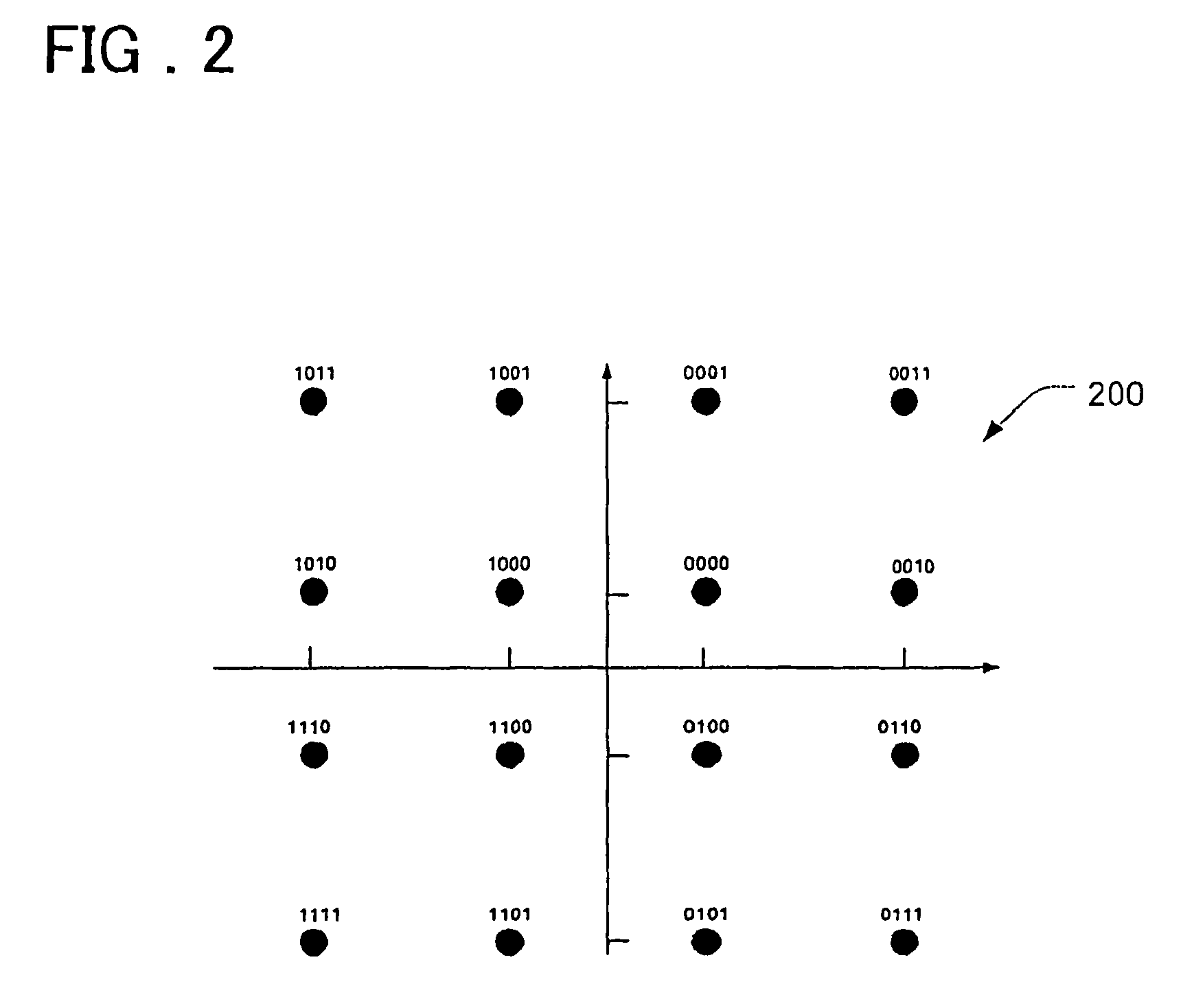Demodulation method
a demodulation method and method technology, applied in the field of demodulation methods, can solve the problems that the above-mentioned ‘normal llr’ method is in general too computationally complex to implement, and achieve the effects of simplifying the conventional llr demodulation method, reducing the number of distance calculations, and less computational complexity
- Summary
- Abstract
- Description
- Claims
- Application Information
AI Technical Summary
Benefits of technology
Problems solved by technology
Method used
Image
Examples
example 1
[0040]A first example of the present invention will be described in the context of a signal modulated using 16-QAM. FIG. 2 depicts the square 16-QAM constellation. The constellation 200 has an index m=2 and is defined to be a signal constellation with 4m points. The square 16-QAM constellation shown in FIG. 2 has an index m=2 and is defined to be a signal constellation with 4m points. Each signal point is denoted by its index (i,j) where 0≦i,jm. The position of each i,j point on the constellation is given by the following formula:
[0041]Ci,j={(2m-1-2i)Δ,(2m-1-2j)Δ}whereΔ=34m-1(12).
[0042]The above formula ensures that the average energy of the signal constellation is normalised to one, where Δ is a normalisation parameter for a square-QAM constellation. For a 16-QAM constellation, m=2 and
[0043]Δ=110.
For other square-QAM constellations, the value of both m and Δ will change. Accordingly, for a 64-QAM constellation, m=3 and
[0044]Δ=142,
whilst for a 256-QAM constellation, m=4 and
[004...
example 2
[0063]The present Invention can be realized with higher order modulation schemes such as 64-QAM. Generally speaking the process followed in this case is the same as for 16-QAM, with the following changes:[0064]As noted above, more thresholds are calculated.[0065]For 64-QAM a different set of constellation reference symbols is used, meaning that a different grey code is needed. This necessitates the use of a different set of criteria for determining the core symbol in step 308. For 64-QAM, given the constellation definition as shown in FIG. 5, the 6 bits for the core symbol (b0-b5) are determined using the following criteria:
[0066]
TABLE 2Criteria for determining core symbol with 64-QAMb0b1b2If y_i ≧ 0If y_q ≧ 0If abs(z_i) ≦ T2b0 = 0b1 = 0b2 = 0ElseElseElseb0 = 1b1 = 1b2 = 1b3b4b5If abs(z_q) ≦ T2If T1 ≦ abs(z_i) ≦ T3If T1 ≦ abs(z_q) ≦ T3b3 = 0b4 = 0b5 = 0ElseElseElseb3 = 1b4 = 1b5 = 1[0067]A different look up table is needed for determining which surrounding reference symbols are to b...
PUM
 Login to View More
Login to View More Abstract
Description
Claims
Application Information
 Login to View More
Login to View More - R&D
- Intellectual Property
- Life Sciences
- Materials
- Tech Scout
- Unparalleled Data Quality
- Higher Quality Content
- 60% Fewer Hallucinations
Browse by: Latest US Patents, China's latest patents, Technical Efficacy Thesaurus, Application Domain, Technology Topic, Popular Technical Reports.
© 2025 PatSnap. All rights reserved.Legal|Privacy policy|Modern Slavery Act Transparency Statement|Sitemap|About US| Contact US: help@patsnap.com



